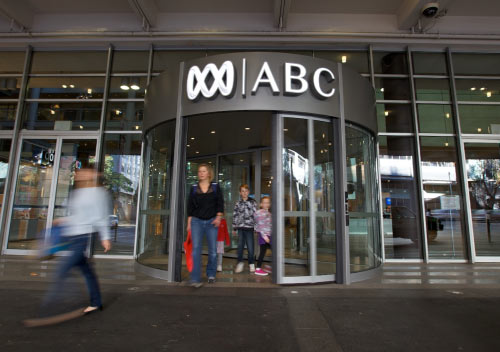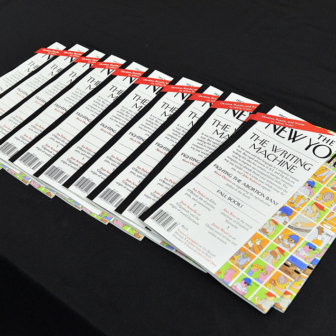HOW MANY SUBMISSIONS from the public constitute an overwhelming response? Last Friday the federal government released more than 2400 submissions to its review of public broadcasting, and the claim has been made that this demonstrates overwhelming public involvement.
Yet twelve years ago when Bob Mansfield conducted his inquiry into the future of the ABC he received over 10,600 submissions – more than four times the current number. It was this convincing evidence of public affection and concern for Auntie that convinced Mansfield the organisation should continue as a broadly based public broadcaster rather than being recreated as an organisation addressing only those types of content that the commercial organisations couldn’t or wouldn’t provide.
Has public support and affection for the ABC declined by more than three quarters? I doubt it. The Mansfield inquiry was better publicised than the present public service led review. As well, in 1997 the ABC was understood to be under imminent threat from the new Howard government. The troops rallied.
Today the medium term threat is just as great – but the troops are diminished in number and distinctly off topic. Many of the lobby groups and individuals whose submissions support the ABC are stuck fighting yesterday’s battles. Often, they have failed to grasp the changes technology brings and the new and fundamental challenges to public broadcasting’s claim on the public purse.
The great majority of submissions to the review are from individuals who love the ABC with a passion. Yet they tend to be hostile to ABC management for, variously, putting too much emphasis on the internet and podcasting, for outsourcing too much production, for not supporting Radio National sufficiently, for being nasty to Stephen Crittenden, for being too “commercial,” for being too downmarket, for screening Spicks and Specks, for not screening Four Corners all year round so on and so forth. All these are legitimate areas of concern. But they are not the main game. The main game is to justify all over again why we should have public broadcasting at all.
Late last year, trying to round up submissions to this review, the Victorian campaign manager for the Friends of the ABC, Glenys Stradijot, reflected sadly in an email to supporters that, since Mansfield, “lifestyle and technology change has resulted in interest of many to act only when quick and easy.” She also celebrated the fact that the Rudd government at least recognised the importance of the ABC.
Yet those same changes of “lifestyle and technology” are the very reason why public input is more than ever necessary. They constitute the main challenge to public broadcasting, and also the main opportunities. To understand why, we only need to look at some of the submissions to the current review. The public broadcasters are being challenged to redefine their purposes and their claims on the taxpayer’s purse.
The challenge is coming not from government, not from the cultural warriors of the right (or not only from them) but from pay television, which barely existed when Mansfield did his work. Channels Nine, Seven and Ten are almost irrelevant in this. The pay television sector understands that the commercial free-to-air business model is broken. Commercial free-to-air television cannot afford to compete with pay television in providing multiple channels of specialised content to niche audiences. To do so would fragment the audience and remove the motivation for mass market advertisers to spend their bucks on television commercials.
Public broadcasters are a different matter. They are, potentially, the main competition for pay television. The ABC doesn’t have to worry about advertising. For Auntie, there is nothing but opportunity in the capacity to provide more and more choice. She already has two digital television channels, and plans several more – a dedicated children’s channel, a public affairs channel, an education channel, and a “best of overseas” channel. SBS also has multiple channels, and plans more.
So in the new battle between pay television and free to air television, the ABC is in the front line. This is why it is the ABC, not the commercial channels, that has taken the lead role in the Freeview organisation, which is leading the free-to-air sector in its marketing efforts. Channels Nine and Seven have not yet even announced what they plan to put on their new multi-channels. In fact, they give the impression of wanting the whole multichannel thing to go away.
This battle between public and pay is not only about government money, but also about spectrum and government favour. Thus we have Foxtel announcing its A-PAC public affairs channel with a cheeky video boasting “at no cost to the taxpayer.” A-PAC was launched by the prime minister late last year – just as the government was considering the ABC’s triennial funding submission, which includes a bid for a public affairs channel. I understand the announcement came as a surprise to the ABC managing director Mark Scott.
Now, in its submission to the current review, the pay television sector has made its challenge to public broadcasting both comprehensive and clear. The submission from ASTRA, the Australian Subscription Television and Radio Association, which includes not only the major subscription television platforms of Foxtel and Austar but also the many channels that provide programming, as well as communications companies such as Optus and Telstra. The former Victorian premier Steve Bracks is its chair. The ASTRA submission is one of the most aggressively argued the government has received.
As well as having some substance, it is a clever exercise in sophistry. ASTRA begins by protesting that its members support public broadcasting. It then goes on to say that the ABC and SBS should receive government money for new channels only in cases where there is a clear market failure. ASTRA contends that there is no evidence of market failure in news reporting, children’s content, education or overseas content. After all, there is Skynews, A-PAC and a big handful of pay television channels devoted to children’s content.
Even if there is a market failure, ASTRA says, then the money to address it should not go straight to the ABC and SBS. The required services should probably be put out to competitive tender. Likewise spectrum. If that is available, it too should be put out to competitive auction, not given to the public broadcasters. (But how is the ABC meant to bid at such auctions, if it only gets public money once market failure has been established?)
ASTRA goes on to argue that the ABC should not be allowed to raise money by selling its content, whether in DVD format or online, in competition with pay television. And it criticises the ABC and SBS for being “increasingly aggressive” in demanding “hold back” clauses in production contracts to block programming being made available to subscription television.
After all this, one is tempted to ask exactly what aspect of public broadcasting it is that ASTRA supports? Perhaps they like Radio National. The ASTRA approach would indeed see the ABC and SBS, if they survived at all, become much smaller organisations forced to compete for funds at every step with the private sector.
The ASTRA submission directly challenges almost every leg of the ABC’s funding pitch and vision. Mark Scott has used words like “market failure” at virtually every opportunity to press his claim for government money for children’s content, investigative journalism and more Australian content. What ASTRA doesn’t say, of course, is that its own claim to satisfy the market is partly smoke and mirrors, because it cannot claim to be a universal service.
The Australian television sector is different from that in the United States and Europe, where pay television has succeeded in signing up a majority of households. Only about a third of Australian homes get subscription television. The subscription fees are not cheap, and not everybody can afford to pay. The ABC and SBS, on the other hand, are almost everywhere, and free.
Within a year or so, once our broadband speeds get up to scratch, most Australians will be able to watch television-type content on the internet. There will be a near limitless amount of content, much of it free. If you haven’t signed up to Foxtel’s highly managed packages of content already, it is hard to see why you would do so once you can get so much content a la carte. So pay television is desperate to establish its continued relevance. In its way, it is just as desperate as commercial free-to air-television.
What do the public broadcasters have to offer to ward off this challenge from pay television? What is their continued claim to taxpayers’ dollars in the face of endless media choice?
The answers emerge from some of the other submissions to the government review. First, there is universality – the ability to reach all Australians. Second, there is the ability to innovate, free from commercial imperatives. And third, there is Australian content, which elsewhere will always tend to be squeezed out by commercial imperatives.
As the Australian Children’s Television Association states in its submission, “the free market conspires against the creation and delivery of Australian programs, especially Australian drama. Providing local content is effectively a gift of government.” The association acknowledges that the pay TV sector is increasingly important to children but points out not only that it is viewed in just a third of Australian homes but also that the main channels screen only about 5.7 per cent of Australian material.
“This lack of universal access combined with relatively low levels of Australian content means that pay television children’s channels remain a relatively minor component in the mix of measures aimed at delivering local content to children,” says the association. “This is a position which is unlikely to change significantly. The pay television sector has consistently sought to distance itself from being tied to cultural outcomes. Furthermore, most pay television local children’s drama relies on significant funding from the commercial broadcasters under the Standards. As pressure on the levels of content created by the Standards continues to grow, the pay television business model for acquiring local children’s drama content will also come under threat.”
Exactly the same arguments could be applied to other kinds of Australian content, such as adult drama and documentary. It should be said, though, that the ABC is doing worse than the commercial networks in screening Australian children’s content. It wants to do better. The planned dedicated children’s channel would screen at least 50 per cent Australian content, and the current funding submission argues for more money for Australian drama.
SO MUCH FOR UNIVERSALITY and Australian content. What about innovation? Various submissions, including those of the ABC and SBS, say that innovation is the thing that makes the ABC and SBS important. The ABC and SBS have led the way in multichannelling and in use of the internet and pioneering innovative drama. What more can be done?
A vision for a uniquely innovative role for public broadcasters is contained in a clutch of submissions by academics from the Queensland University of Technology and the Australian Research Council–funded ARC Centre of Excellence for Creative Industries and Innovation. The approach is neatly summarised on the blog of one of the authors, Terry Flew.
It is a “beyond broadcasting” model that proposes the ABC and SBS should conceive of themselves as not so much as delivery platforms or as institutions but as public services. This pitches the claim for taxpayer’s dollars more broadly than market failure. Says Flew, “The basis for supporting public service media is not simply that of market failure in a limited channel environment, but the capacity to promote innovative, engaging and inclusive Australian information and entertainment content in a world of seemingly limitless media choice.”
What exactly does public service media mean? First, it means decentralisation – allowing a model in which innovation arises around the edges, from the interactions of the users, rather than through central planning. The ABC is already active in this. It has asked for funding to make its local radio presence the basis of “town square” sites in which communities can interact and discuss local affairs. It has also set up Pool, which makes user generated content available for collaboration and remixing. It was mentioned recently by New York University new media guru Jay Rosen (in a Twitter post, aptly) as one of the places that should be watched by those interested in how user generated content might develop.
But Flew says these are not enough. They are “add-ons to a service which continues to emphasise a transmission model of communication, where it is the in-house media professionals who decide what their audiences should receive.” The academics are not proposing that the professional content makers at the ABC and SBS should get the sack, but rather than they should increasingly see their role as working with their audiences to help them become content makers themselves. According to Flew, “The ABC can help to shape this activity in ways that generate greater quality, reach wider audiences, and enable more significant conversations among Australians about matters of shared local, national and international importance.” Meanwhile SBS could make user-generated content the basis of a new relationship with ethnic communities.
“In news and current affairs in particular, SBS has been a leader in provision of international news and information, but this has largely been done off the backs of the big global news agencies,” writes Flew. “Material sourced and distributed through the internet among different communities could provide new windows on world events, with SBS acting as a ‘meta-news-aggregator,’ developing an informal network of specialist ‘reporters’ around particular topic areas and international events.”
The director of the ARC Centre of Excellence for Creative Industries and Innovation, Stuart Cunningham, argues in another submission that it is only in the non-commercial environment that the necessary depth of innovation and risk taking involved in user generated content and pro-am collaborations can occur. In this context it is significant that almost all the substantial submissions to the review argue for the ABC’s rich archives of content to be opened up to the public – something that is already underway on a small scale, as I have reported elsewhere.
Likewise, all the substantial submissions argue for a recasting of the charters of the ABC and SBS, at least to make it clear that broadcasting is no longer the only thing they are about. The kind of innovation envisaged in the academics’ submissions would suggest that more fundamental charter revisions may be necessary – to focus on what the ABC and SBS can do to help others, as well as on what they can provide.
To all this, some would argue – and have already argued – that this kind of innovation is happening in any case, all over the place, without the need for taxpayer’s money being involved. There are plenty of people who argue that in the world of media plenty, there is no reason for having an SBS or an ABC.
SO THERE YOU HAVE the battle lines. Public broadcasting’s claim to continued support is the net effect of its ability to be universal, its (presently unfulfilled) commitment to Australian content, and its capacity to innovate and take risks. Pay television’s claim is that it can also provide specialised quality content to small audiences, that it could be universal if only given the spectrum, and that it costs the taxpayer nothing.
It’s a shame, really, that the inquiry is a limited exercise. There is enough meat here for a white paper on communications policy. It would also help if the Rudd government had come to power with a media policy in place – something that was often promised, but never delivered.
Nevertheless, the government is unlikely to do everything pay television wants. One of its few election commitments for the media sector was to fund the ABC and SBS properly – although nobody has defined what “properly” might mean.
I suspect the results of the present review will be minimal in the short term – a change to the charters, some reorganisation of the back offices so that SBS and the ABC can share some functions. Meanwhile all eyes will be on the budget, and the government’s verdict on the triennial funding submissions by the ABC and SBS. Current indications are that the ABC will get the money it needs for the new children’s channel and some more Australian drama content, but not much else. As for SBS, who knows?
I suspect the bigger questions will, for the moment at least, remain largely unaddressed. •




